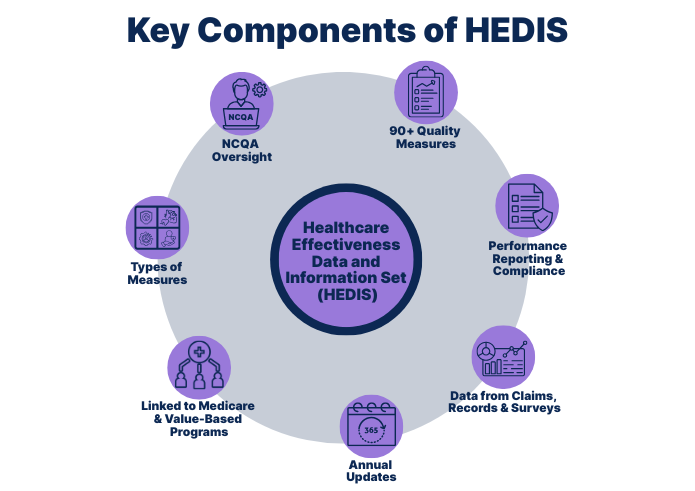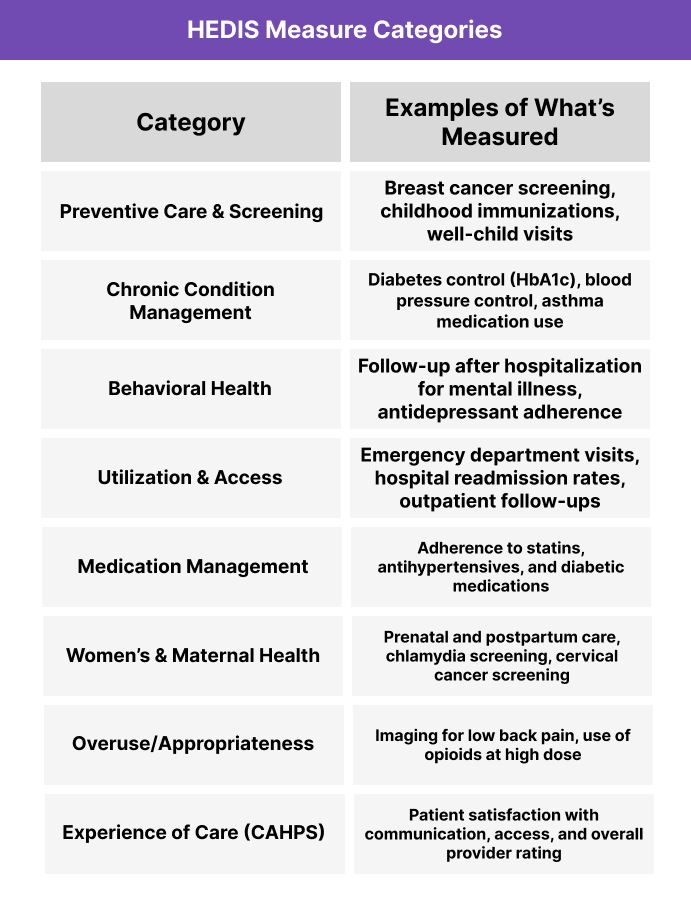What is the Healthcare Effectiveness Data and Information Set (HEDIS)?
HEDIS stands for the Healthcare Effectiveness Data and Information Set, a standardized performance measurement system used by health plans, government programs, and care organizations to evaluate the quality and consistency of care. Developed and maintained by the National Committee for Quality Assurance (NCQA), HEDIS includes dozens of performance measures that track how effectively providers deliver preventive care, manage chronic conditions, and support patient outcomes.
HEDIS data is used by Medicare Advantage plans, Medicaid MCOs, commercial insurers, and ACOs to monitor compliance, benchmark quality, and qualify for incentives in value-based programs. For practices working with managed care or population health contracts, understanding and supporting HEDIS measures is crucial.

Key Components of HEDIS
- Developed and maintained by the National Committee for Quality Assurance (NCQA)
- Tracks clinical quality and care effectiveness across more than 90 standardized measures
- Categories include preventive care, chronic disease management, utilization, and patient experience
- Used by payers and health systems for performance reporting and regulatory compliance
- Data is collected via claims, medical records (chart review), and patient surveys (CAHPS)
- Updated annually (e.g., HEDIS 2024) to reflect current clinical guidelines and industry feedback
- Commonly tied to Medicare Advantage Star Ratings, Medicaid quality scoring, and value-based contracts
How HEDIS Works in Practice
HEDIS measures are used by health plans and care organizations to evaluate performance, improve care delivery, and meet regulatory standards. While HEDIS was originally designed for health plans, its impact now extends to providers, ACOs, CINs, and care teams involved in managing populations across payers.
Here’s How HEDIS Operates on the Ground:
- Measure Selection: Each year, the National Committee for Quality Assurance (NCQA) updates the official HEDIS measure set (e.g., HEDIS 2024), which payers and plans must implement.
- Data Collection: Health plans gather data from three primary sources:
- Provider Impact: Providers contribute to HEDIS performance by:
- Documenting compliant care in the EHR
- Closing care gaps (e.g., scheduling screenings or lab tests)
- Responding to medical record requests from health plans
- Scoring and Reporting: Results are aggregated and submitted to NCQA and CMS. Plans are scored on each measure and compared nationally through tools like:
- Medicare Star Ratings
- State Medicaid quality dashboards
- Employer or exchange plan evaluations
- Incentives and Risk: High HEDIS scores can improve plan bonuses, accreditation status, and network performance rankings, while low scores can trigger remediation or penalties in value-based contracts.

Frequently Asked Questions about HEDIS
1. What is HEDIS?
HEDIS stands for the Healthcare Effectiveness Data and Information Set. It’s a standardized measurement system used by health plans and care organizations to evaluate the quality, access, and outcomes of healthcare services.
2. What does HEDIS stand for?
HEDIS is an acronym for Healthcare Effectiveness Data and Information Set. It was developed by the National Committee for Quality Assurance (NCQA).
3. What are HEDIS measures?
HEDIS measures are standardized metrics used to track how well healthcare providers and plans deliver care. They cover categories such as preventive care, chronic condition management, behavioral health, medication adherence, and patient experience.
4. Who uses HEDIS?
HEDIS is used by:
- Medicare Advantage plans
- Medicaid Managed Care Organizations (MCOs)
- Commercial insurers
- Accountable Care Organizations (ACOs)
- Clinically Integrated Networks (CINs)
It is also referenced in quality reporting and incentive programs across the U.S.
5. How does HEDIS affect providers?
Even though health plans report HEDIS data, providers play a key role in documentation, gap closure, and care delivery that contributes to measure performance. HEDIS results can impact value-based contracts, incentives, and network rankings.
